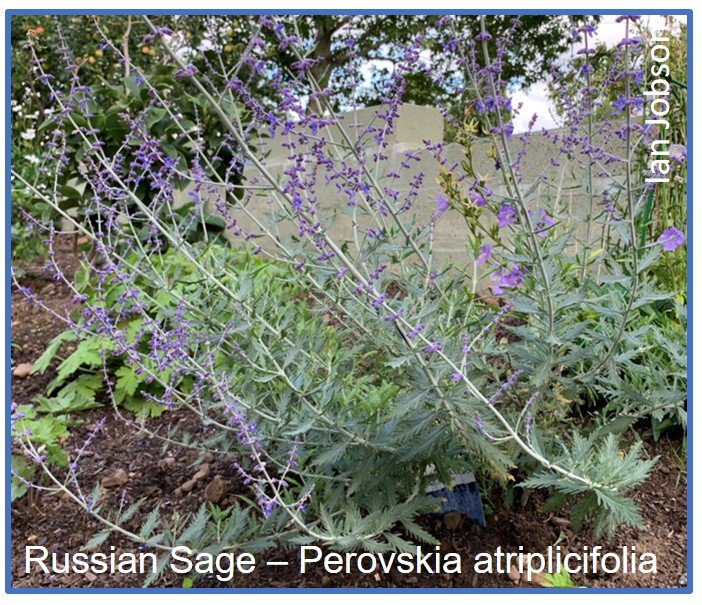

Cultivars are generally superior to seed grown plants. The flowers are attractive to bees and other insects. The species grows 3 to 4 feet tall, producing lavender blue flowers all summer on fine textured, aromatic, gray-green leaves and gray-white stems. atriplicifolia is the only one commonly available. There are seven species of Perovskia, but P. Use it as a specimen in small areas, in mass to intensify its presence in large spaces, or in a long, wide row as a divider hedge.īees are a common visitor to the flowers of Russian sage. It can also be useful as a filler plant or for separating stronger colors. The silvery foliage and open architecture add an almost-Mediterranean feel to the landscape. Other possible combinations include red-leaved barberry or dark green foliage plants for contrast, or blending with other silver-leaved plants.

It combines well with ornamental grasses and white or yellow-flowered perennials, especially white phlox, Rudbeckia (blackeyed Susan) and coreopsis. Perovskia can be used in the middle or back of the border or cottage garden or in many other places in the landscape. Russian sage combines well with yellow flowers.

Russian sage has been in cultivation since the mid-1800’s. The sage reference probably comes from the characteristic sage aroma given off when the leaves are crushed.
/Russiansage-5b3027223418c60036ad5b46.jpg)
Perovskia (pronounced “per-OFF-skee-uh”) is native to Central Asia (Afghanistan, Pakistan, etc.) and Tibet at elevations to 8,000 ft. Perovski, the Turkestani governor of the Russian province of Orenburg – but the plant is not native to Russia or a sage (Salvia). The genus was named by the Russian botanist Karelin about 1840 after B. Russian sage produces small blue flowers on long spikes. This member of the mint family (Labiateae) is hardy in zones 4-9. It superficially resembles lavender, and can be used in areas too cold to grow lavender reliably. This semi-woody plant was named Perennial Plant of the Year in 1995 by the Perennial Plant Association. The tiny, purple-blue, tubular flowers are arranged in whorls along long stems. Russian sage, Perovskia atriplicifolia, is an attractive plant with elongate, gray-green leaves and square, silvery-gray stems that produces an airy cloud of color late in the summer. Dividing the clumps every four to six years reinvigorates the plants and helps to control their spread.Russian sage is a great addition to the border, blooming in late summer. Propagate Russian sage plants by dividing the clumps or taking cuttings in spring. This encourages new growth and a fresh flush of flowers. Remove the top half of the stems if the plant stops blooming in summer. If the plant begins to spread open or sprawl in late spring or summer, shear off the top one-third of the stems to encourage upright growth. When new spring growth emerges, cut the old stems back to just above the lowest set of leaves. Spring and summer care for Russian sage consists mainly of pruning. While allowing the stems and seed pods to remain in the garden until spring creates winter interest, if you prefer a tidier appearance, you can cut the stems back to a foot (.5 m.) above the ground. North of USDA Zone 6, provide a 2-inch (5 cm.) layer of pine needles over winter and remove them in spring when new growth emerges. Scatter a handful of general-purpose fertilizer or a shovelful of compost around each plant every other year in late fall. In fact, Russian sage thrives in dry soil and rarely needs watering once established. Watering care for Russian sage plants is minimal. If you would like to apply mulch around the plants, gravel is a better choice than organic mulch because it allows better moisture evaporation. Water the plants occasionally during dry spells until they are established and growing. Set out new plants in early spring, spacing them 2 to 3 feet (0.5-1 m.) apart. Growing Russian sage in partly shaded locations may cause the plants to sprawl.
Russian sage full#
Choose a location with very well-drained soil of average fertility in full sun. Russian sage is hardy in USDA plant hardiness Zones 5 through 10. It prefers very dry conditions, making it an ideal plant for xeriscaping.
Russian sage how to#
Learning how to grow Russian sage plants is easy, as is Russian sage care. Use Russian sage as a ground cover for open areas or as a specimen plant. The abundant, spiky clusters of flowers bloom from late spring until autumn, almost completely obscuring the leaves. Admired for its silvery gray, fragrant foliage as much as its lavender-purple flowers, Russian sage ( Perovskia atriplicifolia) makes a bold statement in the garden.


 0 kommentar(er)
0 kommentar(er)
